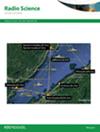Cross-Polarization Gain Calibration of Linearly Polarized VLBI Antennas by Observations of 4C 39.25
IF 1.6
4区 地球科学
Q3 ASTRONOMY & ASTROPHYSICS
引用次数: 0
Abstract
Radio telescopes with dual linearly polarized feeds regularly participate in Very Long Baseline Interferometry. One example is the VLBI Global Observing System (VGOS), which is employed for high-precision geodesy and astrometry. In order to achieve the maximum signal-to-noise ratio, the visibilities of all four polarization products are combined to Stokes I before fringe-fitting. Our aim is to improve cross-polarization bandpass calibration, which is an essential processing step in this context. Here we investigate the shapes of these station-specific quantities as a function of frequency and time. We observed the extra-galactic source 4C 39.25 for 6 hours with a VGOS network. We correlated the data with the DiFX software and analyzed the visibilities with PolConvert to determine the complex cross-bandpasses with high accuracy. Their frequency-dependent shape is to first order characterized by a group delay between the two orthogonal polarizations, in the order of several hundred picoseconds. We find that this group delay shows systematic variability in the range of a few picoseconds, but can remain stable within this range for several years, as evident from earlier sessions. On top of the linear phase-frequency relationship there are systematic deviations of several tens of degrees, which in addition are subject to smooth temporal evolution. The antenna cross-bandpasses are variable on time scales of ∼1 hr, which defines the frequency of necessary calibrator scans. The source 4C 39.25 is confirmed as an excellent cross-bandpass calibrator. Dedicated surveys are highly encouraged to search for more calibrators of similar quality.通过观测 4C 39.25 校准线性极化 VLBI 天线的跨极化增益
具有双线性偏振馈源的射电望远镜经常参与甚长基线干涉测量。其中一个例子是用于高精度大地测量和天体测量的 VLBI 全球观测系统(VGOS)。为了获得最大信噪比,在进行边缘拟合之前,所有四个偏振产品的可见度都要合并为斯托克斯 I。我们的目的是改进交叉偏振带通校准,这是这方面的一个重要处理步骤。在这里,我们研究了这些观测站特定量随频率和时间变化的形状。我们利用 VGOS 网络对银河系外源 4C 39.25 进行了 6 小时的观测。我们用 DiFX 软件对数据进行了关联,并用 PolConvert 对可见度进行了分析,从而高精度地确定了复杂的交叉带通。其频率相关形状的一阶特征是两个正交偏振之间的群延迟,大约为几百皮秒。我们发现,这个群延迟在几皮秒的范围内显示出系统性的变化,但可以在这个范围内保持稳定数年,这一点从之前的会议中可以明显看出。在线性相位-频率关系之外,还存在几十度的系统偏差,此外,这些偏差还受平稳的时间演变影响。天线跨带通在 1 小时的时间尺度上是可变的,这就决定了必要的校准扫描频率。源 4C 39.25 被证实是一个极好的交叉带通校准器。强烈建议进行专门的勘测,以寻找更多类似质量的校准器。
本文章由计算机程序翻译,如有差异,请以英文原文为准。
求助全文
约1分钟内获得全文
求助全文
来源期刊

Radio Science
工程技术-地球化学与地球物理
CiteScore
3.30
自引率
12.50%
发文量
112
审稿时长
1 months
期刊介绍:
Radio Science (RDS) publishes original scientific contributions on radio-frequency electromagnetic-propagation and its applications. Contributions covering measurement, modelling, prediction and forecasting techniques pertinent to fields and waves - including antennas, signals and systems, the terrestrial and space environment and radio propagation problems in radio astronomy - are welcome. Contributions may address propagation through, interaction with, and remote sensing of structures, geophysical media, plasmas, and materials, as well as the application of radio frequency electromagnetic techniques to remote sensing of the Earth and other bodies in the solar system.
 求助内容:
求助内容: 应助结果提醒方式:
应助结果提醒方式:


